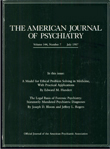SSRIs and Mammoplasia
To the Editor: Mammoplasia (1), nonpuerperal lactation (2), and aggravation of preexisting fibrocystic disease (3) have all been reported in association with the use of selective serotonin reuptake inhibitors (SSRIs). Mammographic changes associated with SSRI use have not been reported previously, to my knowledge. This report is a description of a woman who had mammographic changes during treatment with an SSRI.
Ms. A, a 43-year-old woman with a history of dysthymia and major depression, had a normal baseline mammogram at age 35 and a normal repeat mammogram at age 40. There was no history of fibrocystic disease. Her menstrual periods were regular. She had gained approximately 6 lb and had subjective breast enlargement as a result of fluvoxamine therapy. Approximately 8 months after starting to take fluvoxamine, 50–100 mg/day, she had another routine mammogram.
The mammogram was interpreted as having “bilateral hyperdensities,” and Ms. A was referred to a breast surgeon for consultation. No masses were found during palpation, and a 6-month follow-up mammogram was recommended. Ms. A chose to stop taking fluvoxamine because of concern that the mammoplasia and mammographic changes were related. A non-SSRI antidepressant was substituted, and her breasts returned to normal size. A 6-month follow-up mammogram was normal.
Mammoplasia during SSRI therapy was reported in up to 39% of patients in one study (1). The rate of mammoplasia was unrelated to age, menopausal status, or duration of treatment. Mammoplasia was associated with weight gain in 84% of the patients, and weight gain without mammoplasia occurred in 30% of the patients (1). Serotonergic antidepressants are associated with a risk of nonpuerperal lactation approximately eight times as high as the risk with other antidepressants (2).
These effects are probably mediated by indirect inhibition of dopamine transmission by serotonin. As dopamine is inhibited, prolactin release is disinhibited. This report illustrates that SSRIs may cause not only mammoplasia but also mammographic changes. Clinicians should be aware of this possibility, because this effect can result not only in significant anxiety for the patient but also in referral for consultation with breast specialists who may not be aware of this association.
The clinical significance of these effects is not known. Concern has grown about the long-term risks for women of nonpuerperal elevation of prolactin levels, especially for those with a family history of breast cancer. Research is needed to assess if mammographic changes occur regularly along with mammoplasia associated with SSRI use and whether there are long-term risks associated with SSRI-induced mammoplasia.
1. Amsterdam JD, Garcia-Espana F, Goodman D, Hooper M, Hornig-Rohan M: Breast enlargement during chronic antidepressant therapy. J Affect Disord 1997; 46:151–156Crossref, Medline, Google Scholar
2. Egberts ACG, Meyboom RH, de Koning FH, Bakker A, Leufkens HG: Non-puerperal lactation associated with antidepressant drug use. Br J Clin Pharmacol 1997; 44:277–281Crossref, Medline, Google Scholar
3. McKenzie LJ, Risch SC: Fibrocystic breast disease following treatment with selective serotonin reuptake inhibitors (letter). Am J Psychiatry 1995; 152:471Medline, Google Scholar



